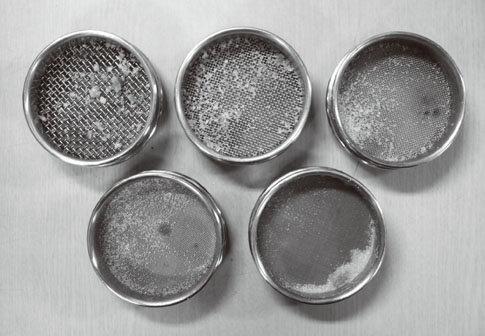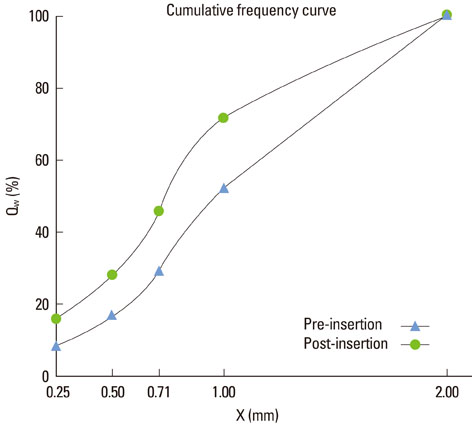J Periodontal Implant Sci.
2011 Apr;41(2):79-85.
Masticatory function following implants replacing a second molar
- Affiliations
-
- 1Department of Periodontology, Research Institute for Oral Sciences, Gangneung-Wonju National University College of Dentistry, Gangneung, Korea. hsum@gwnu.ac.kr
Abstract
- PURPOSE
The aim of this study was to obtain objective and standardized information on masticatory function and patient satisfaction following second molar single implant therapy.
METHODS
Twenty adult patients, who had restored second molar single implants more than 1 month before the study, were enrolled in this study. All patients received a chewing test using peanuts before and after insertion of the implant prosthesis, with a questionnaire and visual analogue scale (VAS) to evaluate the effect of second molar single implant therapy.
RESULTS
This study obtained standardized information on the masticatory function objectively (e.g., P, R, X50) before (Pre-insertion) and after insertion (Post-insertion) of the implant prosthesis. Masticatory performance (P) after insertion of the implant prosthesis significantly increased from 67.8+/-9.9 to 84.3+/-8.5% (P<0.0001). With the implant prosthesis, the P value increased by 24%. The masticatory efficiency index (R) of Post-insertion is higher than that of Pre-insertion (P<0.0001). With the implant prosthesis, the R value increased by 29%. The median particle size (X50) of Post-insertion is lower than that of Pre-insertion (P<0.0001). More than 90% of the patients were satisfied with the second molar single implant therapy from a functional point of view.
CONCLUSIONS
These findings indicate that a second molar single implant can increase masticatory function.
MeSH Terms
Figure
Reference
-
1. Jung UW, Choi JY, Kim CS, Cho KS, Chai JK, Kim CK, et al. Evaluation of mandibular posterior single implants with two different surfaces: a 5-year comparative study. J Periodontol. 2008. 79:1857–1863.
Article2. Mayer TM, Hawley CE, Gunsolley JC, Feldman S. The single-tooth implant: a viable alternative for single-tooth replacement. J Periodontol. 2002. 73:687–693.
Article3. Lee HB, Paik JW, Kim CS, Choi SH, Lee KW, Cho KS. The comparison between the success rates of single implants replacing the mandibular first and second molar. J Korean Acad Periodontol. 2004. 34:101–112.
Article4. Becker W, Becker BE. Replacement of maxillary and mandibular molars with single endosseous implant restorations: a retrospective study. J Prosthet Dent. 1995. 74:51–55.
Article5. Levin L, Laviv A, Schwartz-Arad D. Long-term success of implants replacing a single molar. J Periodontol. 2006. 77:1528–1532.
Article6. Jung SW, Lee JK, Um HS, Chang BS. A retrospective study on survival rate of the most posterior single tooth implant. J Korean Acad Periodontol. 2008. 38:611–620.
Article7. Muftu A, Chapman RJ. Replacing posterior teeth with freestanding implants: four-year prosthodontic results of a prospective study. J Am Dent Assoc. 1998. 129:1097–1102.
Article8. Schwartz-Arad D, Samet N, Samet N. Single tooth replacement of missing molars: a retrospective study of 78 implants. J Periodontol. 1999. 70:449–454.
Article9. Shugars DA, Bader JD, Phillips SW Jr, White BA, Brantley CF. The consequences of not replacing a missing posterior tooth. J Am Dent Assoc. 2000. 131:1317–1323.
Article10. Yurkstas AA. The effect of missing teeth on masticatory performance and efficiency. J Prosthet Dent. 1954. 4:120–123.
Article11. van der Bilt A, Olthoff LW, Bosman F, Oosterhaven SP. Chewing performance before and after rehabilitation of post-canine teeth in man. J Dent Res. 1994. 73:1677–1683.
Article12. Boretti G, Bickel M, Geering AH. A review of masticatory ability and efficiency. J Prosthet Dent. 1995. 74:400–403.
Article13. Bates JF, Stafford GD, Harrison A. Masticatory function - a review of the literature. III. Masticatory performance and efficiency. J Oral Rehabil. 1976. 3:57–67.14. Lucas PW, Luke DA. Methods for analysing the breakdown of food in human mastication. Arch Oral Biol. 1983. 28:813–819.
Article15. Olthoff LW, van der Bilt A, Bosman F, Kleizen HH. Distribution of particle sizes in food comminuted by human mastication. Arch Oral Biol. 1984. 29:899–903.
Article16. Manly RS, Braley LC. Masticatory performance and efficiency. J Dent Res. 1950. 29:448–462.
Article17. Edlund J, Lamm CJ. Masticatory efficiency. J Oral Rehabil. 1980. 7:123–130.
Article18. van der Bilt A, Olthoff LW, Bosman F, Oosterhaven SP. The effect of missing postcanine teeth on chewing performance in man. Arch Oral Biol. 1993. 38:423–429.
Article19. Cho LL, Kim KN, Chang IT, Heo SJ. A Study on the effects of chewing patterns to occlusal contact points and chewing efficiency. J Korean Acad Craniomandib Disord. 1994. 6:125–135.20. Sierpinska T, Golebiewska M, Lapuc M. The effect of mastication on occlusal parameters in healthy volunteers. Adv Med Sci. 2008. 53:316–320.
Article21. Gambareli FR, Serra MD, Pereira LJ, Gaviâo MB. Influence of measurement technique, test food, teeth and muscle force interactions in masticatory performance. J Texture Stud. 2007. 38:2–20.
Article22. Katsuhiko K, Takahiro O, Garrett NR, Minoru T. Assessment of masticatory performance: methodologies and their application. Prosthodont Res Pract. 2004. 3:33–45.23. Yurkstas AA. The masticatory act: a review. J Prosthet Dent. 1965. 15:248–260.24. Buschang PH. Masticatory ability and performance: the effects of multilated and maloccluded dentitions. Semin Orthod. 2006. 12:92–101.
Article25. Vinton P, Manly RS. Masticatory efficiency during the period of adjustment to dentures. J Prosthet Dent. 1955. 5:477–480.
Article26. Abel LF, Manly RS. Masticatory function of partial denture patients among navy personnel. J Prosthet Dent. 1953. 3:382–392.
Article27. Yurkstas A, Fridley HH, Manly RS. A functional evaluation of fixed and removable bridgework. J Prosthet Dent. 1951. 1:570–577.
Article28. Kapur K, Soman S, Yurkstas A. Test foods for measuring masticatory performance of denture wearers. J Prosthet Dent. 1964. 14:483–491.
Article29. Pjetursson BE, Karoussis I, Bürgin W, Brägger U, Lang NP. Patients' satisfaction following implant therapy. A 10-year prospective cohort study. Clin Oral Implants Res. 2005. 16:185–193.
Article30. Pera P, Bassi F, Schierano G, Appendino P, Preti G. Implant anchored complete mandibular denture: evaluation of masticatory efficiency, oral function and degree of satisfaction. J Oral Rehabil. 1998. 25:462–467.
Article31. Woodmansey KF, Ayik M, Buschang PH, White CA, He J. Differences in masticatory function in patients with endodontically treated teeth and single-implant-supported prostheses: a pilot study. J Endod. 2009. 35:10–14.
Article32. Kim SK, Kin ME, Kim KS. Intra- and inter-examiner reliability on the estimation of masticatory efficincy: by pulverizing peanuts with a sieve-system. J Korean Acad Oral Med. 2002. 27:381–389.33. Engfors I, Ortorp A, Jemt T. Fixed implant-supported prostheses in elderly patients: a 5-year retrospective study of 133 edentulous patients older than 79 years. Clin Implant Dent Relat Res. 2004. 6:190–198.
Article34. Jemt T. Failures and complications in 391 consecutively inserted fixed prostheses supported by Brånemark implants in edentulous jaws: a study of treatment from the time of prosthesis placement to the first annual checkup. Int J Oral Maxillofac Implants. 1991. 6:270–276.
- Full Text Links
- Actions
-
Cited
- CITED
-
- Close
- Share
- Similar articles
-
- The Comparison between the success rates of single implants replacing the mandibular first and second molar
- Short-term improvement of masticatory function after implant restoration
- A STUDY ON MAXIMUM BITE FORCE AFTER DENTAL IMPLANTATION
- Association between masticatory ability, oral health-related quality of life and cognitive function in the elderly population using structural equation modeling
- The study on success rate of single implant replacing the mandibular first and second molars



